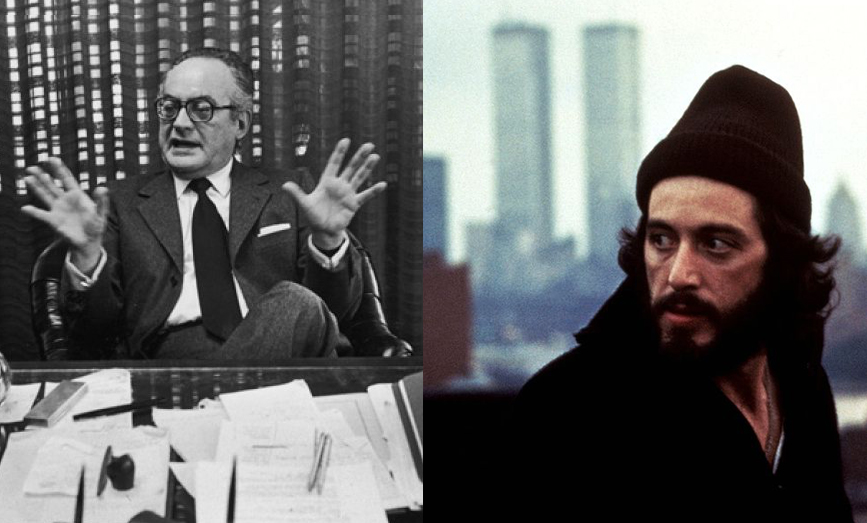This week at TFE we're celebrating the centennial of one of cinema’s most prolific and legendary producers, Dino De Laurentiis. In part one we looked at his breakout Italian hit, in part two an expensive epic flop. Here's Mark Brinkerhoff as Dino crosses the Ocean...
 Dino in 1970, and Al Pacino in Serpico (1973)
Dino in 1970, and Al Pacino in Serpico (1973)Dino De Laurentiis stormed Hollywood in the early ‘70s, quickly on the heels of fantastic successes like 1968’s Barbarella and Danger: Diabolik, which essentially closed out his previous decade (“essentially” because, man oh man, was this man ever prolific).
Having branched from Neo-Italian into more international, English-language cinema, De Laurentiis set his sights on riding the New Hollywood wave then cresting. While still making the occasional spaghetti western and period piece, his films began to dabble more in contemporary themes. In fact, aside from The Valachi Papers (1972), his The Godfather manqué, De Laurentiis’ initial forays into filming stateside resulted in his grittiest, most modern productions to date...


Speaking of The Godfather, De Laurentiis enlisted that film’s breakout star, Al Pacino (“Best Supporting Actor” my ass), to headline Serpico (1973), Sidney Lumet's bracing adaptation of the true story of a New York City police officer who blew the lid wide open on systemic corruption within the NYPD. Though casting Pacino to play the real-life cop might seem like a no-brainer today, it may not have been back then...
To Pacino, at peak hotness, the chance to portray someone who ventured dangerously off the map in order to expose his corrupt fellow officers must’ve been irresistible. But for De Laurentiis, who called the shots from behind the scenes, it was still a gamble—one that paid off splendidly. (The film, which racked up Oscar nominations for Best Actor and Best Adapted Screenplay [Waldo Salt’s penultimate], was one of the dozen highest-grossing movies that year.)
During the time of Serpico’s release, De Laurentiis already was hard at work on his next project (and perhaps his most enduring franchise), the icky vigilante film, Death Wish (1974). Post-Dirty Harry and pre-Taxi Driver, the Charles Bronson-fronted revenge fantasy—the first in a series of five (!!!) films—surely tapped into the angst of American urban culture in the ‘70s. It was as violent and graphic as the nightmares of city-dwellers worried about rising crime rates in cities that were turning into a seeming hell. And it became, of course, a zeitgeist hit (not to mention the screen debut of Jeff Goldblum and Denzel Washington).

Yes, Death Wish hit a nerve, and continued to hit it over, and over, and over again, over a 20-year period. That the original Death Wish let Bronson loose on those who killed his wife and brutalized his daughter, a concept that seems awfully tired (at least to me), its staying power is not to be underestimated. Consider that Hollywood released a Death Wish remake (starring Bruce Willis and Elisabeth Shue) just last year!
It’s remarkable, though perhaps unsurprising, that De Laurentiis had such big commercial (if not critical) hits off the bat (which he followed up with the not-to-be-discussed Mandingo, because, oh my God, do we have to?!). Clearly the man had taste in material, even when his choice of material could sometimes veer toward the tasteless.
 Years after having formed (then folded) a studio in Italy, De Laurentiis established his own production facility stateside, in Wilmington, North Carolina of all places. (Fun fact: I’ve actually seen the former De Laurentiis Entertainment Group [DEG] studios in Wilmington, where my sister lives. They’re now called EUE/Screen Gems Studios.)
Years after having formed (then folded) a studio in Italy, De Laurentiis established his own production facility stateside, in Wilmington, North Carolina of all places. (Fun fact: I’ve actually seen the former De Laurentiis Entertainment Group [DEG] studios in Wilmington, where my sister lives. They’re now called EUE/Screen Gems Studios.)De Laurentiis relocated to the U.S. in 1976, where he became a citizen a decade later.
Continue to Part 4: The hubristic remake of King Kong.